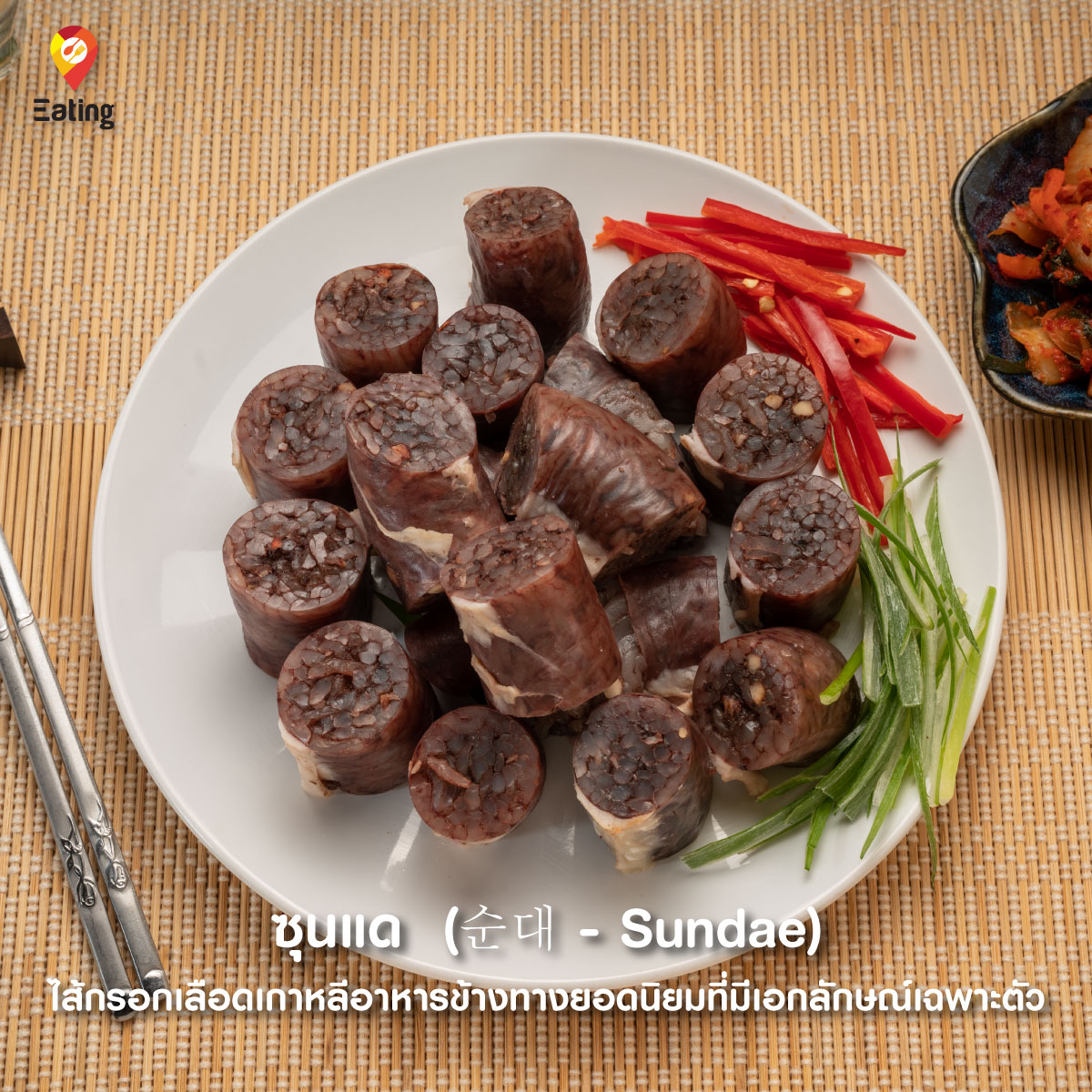Insider
New Experience

ซุนแด(Sundae)
ไส้กรอกเลือดเกาหลีอาหารข้างทาง ยอดนิยมที่มีเอกลักษณ์เฉพาะตัว
ไส้กรอกเลือดเกาหลี หรือที่เรียกว่า "ซุนแด" (Sundae, 순대) เป็นหนึ่งในอาหารเกาหลีที่เก่าแก่และเป็นเอกลักษณ์ ซุนแดไม่เพียงแต่เป็นสตรีทฟู้ดยอดนิยม แต่ยังมีประวัติศาสตร์อันยาวนานที่เกี่ยวข้องกับวัฒนธรรมการบริโภคอาหารของชาวเกาหลีมาตั้งแต่อดีต
.
เชื่อกันว่าซุนแดได้รับอิทธิพลจากวัฒนธรรมไส้กรอกเลือดของจีนและมองโกเลีย ซึ่งมีประเพณีการใช้ส่วนต่างๆ ของสัตว์ให้เกิดประโยชน์สูงสุด รวมถึงเลือดที่มักถูกนำมาใช้ทำไส้กรอก เลือดสัตว์เป็นวัตถุดิบสำคัญในอาหารของชนเผ่าเร่ร่อนในเอเชียกลาง และแนวคิดนี้ถูกเผยแพร่ไปยังเกาหลีผ่านทางเส้นทางการค้าและการรุกรานในอดีต
.
ยุคโชซอน (Joseon, 1392–1897) เอกสารทางประวัติศาสตร์ของเกาหลีในยุคโชซอนมีการกล่าวถึง "ซุนแด" ว่าเป็นหนึ่งในอาหารที่ถูกใช้ในพิธีกรรมสำคัญ เช่น งานแต่งงานและงานเซ่นไหว้บรรพบุรุษ ชาวเกาหลีนิยมใช้เลือดสัตว์ (ส่วนใหญ่เป็นหมูหรือวัว) ผสมกับธัญพืช เช่น ข้าวบาร์เลย์และข้าวเหนียว ก่อนนำไปยัดใส่ไส้หมูแล้วต้มจนสุก
.
ในยุคนี้ ซุนแดยังเป็นอาหารที่หาทานได้ยากและมักถูกเสิร์ฟในราชสำนักหรือบ้านของชนชั้นสูงเท่านั้น เนื่องจากวัตถุดิบหลัก เช่น เนื้อสัตว์และเลือดหมู ยังถือเป็นของมีค่าและไม่ได้มีการผลิตในปริมาณมากเหมือนในปัจจุบัน
.
วิวัฒนาการของซุนแดในยุคสมัยใหม่ การเปลี่ยนแปลงในยุคอาณานิคมญี่ปุ่น (1910–1945)
.
ในช่วงที่เกาหลีตกอยู่ภายใต้การปกครองของญี่ปุ่น อุตสาหกรรมอาหารได้รับผลกระทบอย่างหนัก ญี่ปุ่นมีอิทธิพลต่ออาหารเกาหลีหลายชนิด รวมถึงซุนแด ซึ่งในยุคนี้เริ่มมีการเปลี่ยนสูตรให้มีส่วนผสมที่หลากหลายขึ้น เช่น การใส่ก๋วยเตี๋ยวหรือวุ้นเส้นมันเทศ (Dangmyeon, 당면) เพื่อเพิ่มปริมาณและลดต้นทุน
.
ซุนแดหลังสงครามเกาหลี (1950–1953) หลังสงครามเกาหลี อาหารขาดแคลนอย่างรุนแรง ทำให้ประชาชนต้องหาวิธีปรับตัวและใช้วัตถุดิบที่มีอยู่ให้คุ้มค่าที่สุด ซุนแดกลายเป็นอาหารราคาถูกที่สามารถทำได้ง่ายและให้พลังงานสูง ผู้คนเริ่มนิยมใส่วุ้นเส้นมันเทศมากขึ้นเพราะสามารถหามาทดแทนข้าวที่ยังมีราคาสูงได้
.
นอกจากนี้ ซุนแดยังกลายเป็นอาหารข้างทางยอดนิยม เนื่องจากพ่อค้าแม่ค้าสามารถผลิตได้ในปริมาณมากและขายในราคาถูก เป็นที่นิยมโดยเฉพาะในตลาดกลางคืนและย่านคนทำงานที่ต้องการอาหารอิ่มท้องแต่ราคาไม่แพง
.
ทุกวันนี้ ซุนแดกลายเป็นหนึ่งในอาหารที่ได้รับความนิยมสูงในเกาหลีใต้ สามารถพบได้ทั่วไปตามแผงขายอาหารข้างทาง ไปจนถึงร้านอาหารเฉพาะทาง ซุนแดยังปรากฏในรายการโทรทัศน์และซีรีส์เกาหลีหลายเรื่อง ทำให้เป็นที่รู้จักไปทั่วโลก
History of Korean Blood Sausage (Sundae - 순대)
Korean blood sausage, known as "Sundae" (순대), is one of Korea’s oldest and most distinctive foods. Not only is Sundae a popular street food, but it also has a long history closely tied to the dietary culture of Koreans from ancient times to the present.
.
Ancient Influences from China and Mongolia
It is believed that Sundae was influenced by the blood sausage traditions of China and Mongolia. These cultures emphasized using every part of an animal, including blood, which was often used to make sausages. Blood was an important ingredient in the diets of Central Asian nomadic tribes, and this concept spread to Korea through trade routes and past invasions.
.
Joseon Dynasty (1392–1897)
Historical records from the Joseon era mention Sundae as a food used in important ceremonies, such as weddings and ancestral rites. Koreans at the time commonly used animal blood (mostly from pigs or cows) mixed with grains like barley and glutinous rice before stuffing it into pig intestines and boiling it until cooked.
.
During this period, Sundae was a rare and luxurious dish, typically served in royal courts or the households of the upper class. Meat and pig’s blood were considered valuable ingredients and were not as widely available as they are today.
.
Evolution of Sundae in Modern Times
Changes During Japanese Colonial Rule (1910–1945)
During Japan's occupation of Korea, the food industry suffered greatly. Japanese influence altered many Korean dishes, including Sundae. This era saw recipe modifications, such as adding glass noodles (Dangmyeon, 당면) to increase volume and reduce production costs.
.
Sundae After the Korean War (1950–1953)
After the Korean War, severe food shortages forced people to adapt and maximize the use of available ingredients. Sundae became an affordable, high-energy food that was easy to produce. The use of glass noodles increased significantly as a substitute for rice, which remained expensive at the time.
.
Additionally, Sundae became a popular street food because vendors could produce it in large quantities and sell it at low prices. It became especially popular in night markets and working-class neighborhoods, where people sought filling yet inexpensive meals.
Sundae in the Modern Era Popularity in Korean Culture Today, Sundae is one of the most popular foods in South Korea. It can be found everywhere, from street food stalls to specialty restaurants. Sundae frequently appears in Korean TV shows and dramas, helping to introduce it to international audiences.
...
Types of Sundae
Different regions in Korea have their own unique Sundae recipes, such as:
.
Traditional Sundae (순대) – Made with pig’s blood, glass noodles, and spices.
Sundae in Soup (순댓국 - Sundae-guk) – A soup containing Sundae and pig offal, simmered in pork bone broth.
Squid Sundae (오징어순대 - Ojingeo Sundae) – Uses squid instead of pig intestines, stuffed with rice and vegetables.
Spicy Sundae (매운 순대 - Maeun Sundae) – A spicy version of Sundae with added chili for extra heat.
Traditional Ways to Eat Sundae
Dipped in salt (소금 - Sogeum) – The traditional way to enhance Sundae’s natural flavors.
With gochujang (고추장) or chili sauce – Adds a spicy and tangy kick.
With tteokbokki (떡볶이) – Often served alongside the spicy sauce of tteokbokki.
As Sundae soup (순댓국) – Served in a rich, flavorful broth with green onions.
Conclusion
Sundae is a prime example of a dish that has evolved and adapted over time. From a rare delicacy in the Joseon royal courts to a widely available street food, Sundae reflects the history and lifestyle of Korean society throughout different eras.
.
Today, Sundae is not only beloved in South Korea but is also gaining recognition worldwide, thanks to the global Korean Wave (Hallyu) that has sparked international interest in Korean cuisine.